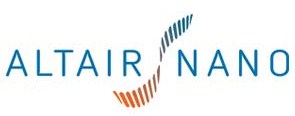Brands and uses
This section contains content that is written like an advertisement .(October 2019) |
Log9 Materials
The Log9 company is working to introduce its tropicalized-ion battery (TiB) backed by lithium ferro-phosphate (LFP) and lithium-titanium-oxide (LTO) battery chemistries. Unlike LFP and LTO, the more popular NMC (Nickel Manganese Cobalt) chemistry does not have the requisite temperature resilience to survive in the warmest conditions such as in India. LTO is not only temperature resilient, but also has a long life. [15]
Altairnano
Altairnano produces lithium-titanate batteries under the "Nanosafe" line, mainly for battery electric vehicles. Vehicle manufacturers that have announced plans to use Altairnano batteries include Lightning Car Company, which plans to use them for the Lightning GT, an electric sports car; [16] [17] Phoenix Motorcars, for use in its electric sport-utility vehicles; [18] and in Proterra, its electric EcoRide BE35 lightweight 35-foot bus. [19]
Altairnano has also deployed their lithium-titanate energy storage systems for electric grid ancillary services [20] as well as military applications. [21]
Grinergy
Grinergy is a South Korean battery manufacturer founded in 2017. It offers commercial and Warfighter military grade LTO battery technology. [22] Grinergy is a 2023 CES Innovation Honoree [23]
Leclanché
Leclanché is a Swiss battery manufacturer founded in 1909. In 2006, it acquired Bullith AG (Germany) to establish a Li-Ion manufacturing line in Germany. In 2014, their product "TiBox" entered the market. The energy content of the TiBox is 3.2 kWh, with an expected 15,000 cycle life span. [24]
Microvast
Microvast, based in Houston, Texas, makes a lithium-titanate battery that it calls "LpTO". In 2011, the world's first ultrafast charge bus fleet was launched in Chongqing, China. An 80 kWh LpTO battery system was installed in 37 twelve-meter electric buses, which can be fully charged within 10 minutes with a 400 kW charger. [25]
As of 2014, a British bus OEM, Wrightbus, began using Microvast LpTO batteries for 1,000 units of double-decker New Routemaster buses.[ citation needed ] An 18 kWh LpTO battery system is used to replace the initial Lithium Iron Phosphate battery because the LFP battery encountered performance failure.
As of 2015, the European ZeEUS (zero emission urban transport system) was first offered. Its VDL bus uses a 62.5 kWh LpTO battery system from Microvast [26] for a demonstration project.
As of 2016, the world's largest automated port, PSA TUAS, began using the Microvast LpTO for 22 electric AGVs as a first phase of a project for horizontal container transportation. [27]
Samsung
The Bluetooth-enabled S-Pen in the Samsung Galaxy Note 10 and 10+ contains a lithium-titanate battery which has a stand-by time of ten hours. [28]
Seiko
Seiko uses lithium-titanate batteries in its Kinetic (automatic quartz) wristwatches. Earlier Kinetic watches used a capacitor to store energy, but the battery provides a larger capacity and a longer service life. A technician can easily replace the battery when its capacity eventually deteriorates to an unacceptable level. [29]
Toshiba

Toshiba released a lithium-titanate battery, dubbed "Super Charge Ion Battery" (SCiB). [30] [31] The battery is designed to offer 90% charge capacity in ten minutes. [32]
SCiB batteries are used in the Schwinn Tailwind electric bike. [33] Toshiba has also demonstrated its use as a prototype laptop battery. [34] Toshiba SCiB batteries are used in a Japan-only version of Mitsubishi's i-MiEV and Minicab MiEV [3] electric vehicles, and Honda uses them in its EV-neo electric bike and Fit EV, which came to market in the summer of 2012. [4] [5] JR Central's N700S Shinkansen uses SCiB batteries to operate at low speed in the event of a disruption to overhead power. [35]
The Toshiba lithium-titanate battery is low voltage (2.3 nominal voltage), with low energy density (between the lead-acid and lithium ion phosphate), but has extreme longevity, charge/discharge capabilities and a wide range operating temperatures.
YABO
YABO Power Technology released a lithium-titanate battery in 2012. The standard model YB-LITE2344 2.4V/15Ah battery cell has been used in electric vehicle and energy storage systems. [36]
Yinlong Energy
Gree introduced its Yinlong Battery Technology, a type of fast-charging LTO (lithium-titanate) battery, which can operate in extreme temperature conditions. The batteries have an operational life-span up to 30 years. Yinlong Energy provides batteries for such uses as automobiles and energy storage. [37]












